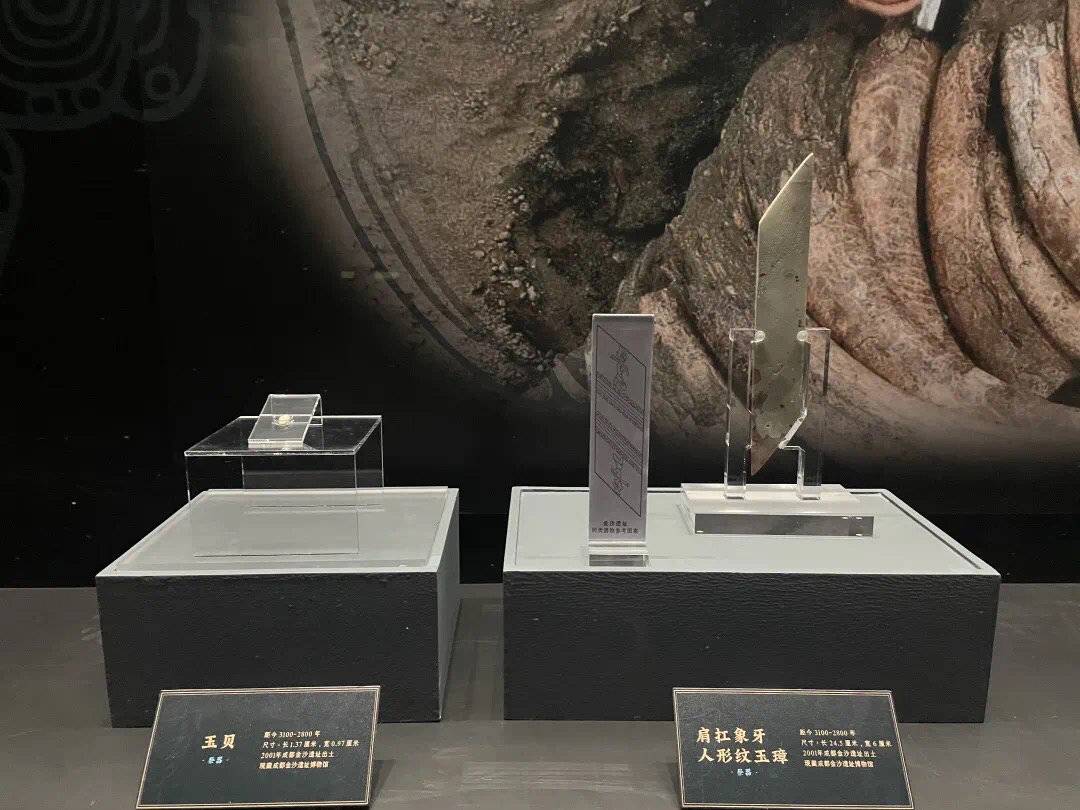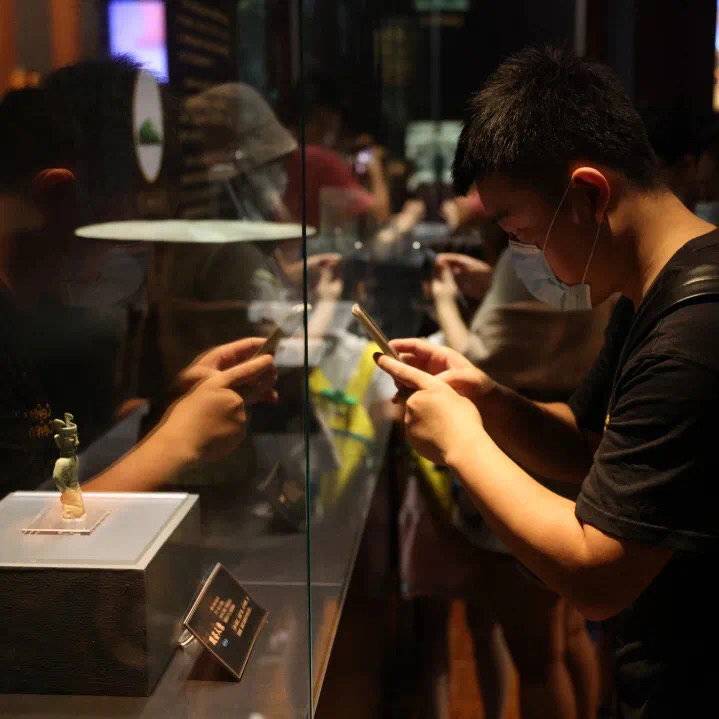Sanxingdui Jinsha accompanied the "business trip" Shenzhen 14 national treasures to reproduce the sacrifice scene of the ancient Shu Kingdom
Author:Cover news Time:2022.08.02

Yubei and Yuzhang unearthed from the Jinsha site
Cover Journalist Zeng Jie intern Lin Xiaotu According to the Shenzhen Museum
In the hot summer, the ancient Shu national treasures held up in Shenzhen and set off a wave of watching. On August 2nd, the cover journalist learned from the Chengdu Sands Site Museum that it was co -organized by the Shenzhen Museum and the Southern University of Science and Technology, the Samsung Sanxingdui Museum in Sichuan, and the Chengdu Sands Site Museum. The exhibition of Huya is exhibited at the ancient art museum of the Shenzhen Museum. This "small and refined" exhibition exhibited 14 (sets) first -class cultural relics. Mask and other cultural relics reproduce the sacrifice scene of the ancient Shu Kingdom.
The brilliant ancient Shu civilization is an important part of the diversified Chinese civilization. Various cultural relics unearthed from the Sanxingdui site and the Jinsha site have always attracted the attention of the world. In particular, a new round of archeological excavations in the Samsung Douzhe has obtained a number of important gains. The number of newly discovered the number of cultural relics, the essence of production, and the strange shape is amazing. The exhibition was very hot, and the first weekend attracted a large number of Shenzhen citizens to come to watch the exhibition.
This is not the first time that Samsung Dou and Sands have appeared in Shenzhen. As early as 2009, the Shenzhen Museum held a large -scale cultural relic exhibition "The Mysterious Ancient Shu Kingdom -Sanxingdui and Sands Unearthed Cultural Relics Treasure Exhibition". After 13 years, Tang Jigen, a well -known archeological expert and a professor of the Cultural Heritage Research Center of the University of Science and Technology, used physical relics and 3D printing cultural relics to simulate the sacrifice scene of the ancient Shu country with physical relics and 3D printing cultural relics.
The "Understanding Sanxingdui" exhibition is divided into three units: the sacrifice, Jianmu Tongtian, and the worship. Set) are all first -class cultural relics, which show the scenes of the ancient Shu Kingdom more than 3,000 years ago.

Ivory unearthed from the Jinsha site
Through the exhibition scene simulation and precious unearthed cultural relics, citizens can appreciate the essence of the ancient Shu nation's sacrifice culture, and feel the communication and integration of bronze civilization in the Yangtze River Basin and the Yellow River Basin.
The Archaeological Expert of the University of Science and Technology Tang Jigen used physical and technological exhibition methods to restore the sacrifice scene of Sanxingdui with physical relics and 3D printing cultural relics. Those who are unpredictable and shrouded in Sanxingdui civilization, so they can see the day in Shenzhen.
Heavy National Treasures Missing Shenzhen
The 8 cultural relics sent by Sanxingdui are first -level cultural relics unearthed from the No. 1 and 2 sacrifice pit in 1986, including copper mask, copper avatar, copper kneeling portrait, copper Zun, Huya, and jade. Essence The latest unearthed Bronze portrait of the Ultraman wearing a sharp hat portrait, and the bronze -kneeling portrait appeared in the exhibition hall in the form of 3D printing cultural relics.

Samsung Ding Copper Avatar
Among the cultural relics of Jinsha, there are both the shoulder -shaped ivory patterns and jade and jade of the shoulders of the Shang and Zhou dynasties, as well as stone tigers, stone snakes, stone knelt sitting portraits, small stone pupae, and ivory, which complement the cultural relics unearthed from Samsung Dou.
Both Sanxingdui and Sands were unearthed in jade. The three jade stalks exhibited in this exhibition each had their own advantages. "Zhou Li" was once one of the Liurui, and it was an important ceremony in ancient Chinese sacrifice activities, and it was also a representative of social levels and power. There are more than 200 jade stories unearthed from the Jinsha site, with gorgeous colors, diverse forms, and delicate and delicate carving. Has distinctive regional characteristics.
It is worth noting that the shoulder of the Sands Site is carried by ivory patterns, and the same patterns are engraved on both sides. superior. Some scholars believe that this piece of jade reflects the scene of the ancient Shu people carrying ivory for sacrifice activities. This vivid picture is reflected with the sacrifice scene restored by the exhibition hall.

Citizens take pictures at the exhibition
In "Zhou Li · Qiu Guan · Hugu", there are records about the use of ivory to kill the god of water: "The pot of the pot is beaten by the drum of the artillery, and the stone is incinerated. If you want to kill his god, It is sinking with the atomic tooth at noon, then its god dies, and the relic is the tomb. "Among them, the teeth are ivory. In the ancient Shu period, the Chengdu Plain often caused flood disasters. The ancient Shu people sacrificed with ivory, and maybe they also hope that ivory can kill the river in the river, and bless their homes without being flooded.
Restore the sacrifice scene of the ancient Shu Kingdom
The six buried pit discovered by Sanxingdui in the academic community is a sacrifice pit, but who sacrifices and how sacrifice has always been conclusive. Tang Jigen hopes to use the exhibition to complete the interpretation of the sacrifice phenomenon. The complete sacrifice activities include at least four parts: the sacrifice, the sacrifice, the sacrifice, and the sacrifice method. What about sacrifice.
As a result, the audience can see such a scene in the exhibition hall of the Shenzhen Museum: In the first unit "sacrifice", the bronze stand -up people stand in the high stage, wearing a dragon pattern, wearing the "Tianmu Crown". Holders with both hands, as the main sacrifice; bronze kneeling position respects portrait portrait, bronze knees to hold portrait portrait, bronze beast crown portrait, bronze kneeling and portrait, etc. people.

Exhibition restores the sacrifice scene of the ancient Shu Kingdom
The second unit "Jianmu Tongtian" is used as a copy of the No. 2 bronze tree unearthed from Sanxingdui No. 2 sacrifice pit as the core of the display, showing that the ancient Shu people conveyed their thoughts to Shangtian through the god tree. Human -faced birds fly between the sacrifice and the bronze tree, showing the association between the sacrifice and the god tree, which is an important proof of "building wood". The third unit, "The sacrifice", is represented by the sacrifice with vertical masks, drum masks, etc., and its biggest feature is that it is suspended or standing at a high place, and does not show physical movements.
Through the exhibition scene simulation and precious unearthed cultural relics, citizens can appreciate the essence of the ancient Shu nation's sacrifice culture, and feel the communication and integration of bronze civilization in the Yangtze River Basin and the Yellow River Basin.
It is reported that after the Shenzhen Museum's exhibition is new, it attracts citizens to line up to watch the legend of ancient Shu. The Ancient Art Museum of Shenzhen Museum (located at No. 6, Futian District), and the History Folk Customs Museum (located in District A, Futian District) from August 2nd to August 31st, 2022, the opening time of Tuesday to Sunday will be opened on Tuesday to Sunday. Ahead of time to 9:30 am, it is convenient for more citizens to appreciate the essence of ancient Shu civilization this summer vacation.
- END -
Time | Ren Liming: bus 27
Text/Ren LimingQQ, who was silent for many years, suddenly flashed. I saw him. I was on bus 27. After so many years, I did not expect that Low 27 was still driving as before. I sent it for a while.T
White tea stores both seal and ventilation, isn't it contradictory?

丨 This article was originally created by Xiao Chen tea 丨 first issued on...